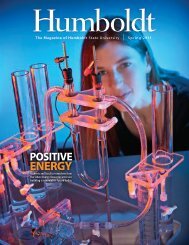Unveiled - Humboldt Magazine - Humboldt State University
Unveiled - Humboldt Magazine - Humboldt State University
Unveiled - Humboldt Magazine - Humboldt State University
You also want an ePaper? Increase the reach of your titles
YUMPU automatically turns print PDFs into web optimized ePapers that Google loves.
the two counties for their<br />
study because the Agricultural<br />
Worker Health Initiative,<br />
a project focused<br />
on worker health and political<br />
empowerment, was<br />
already in place<br />
Steve says the DPR is<br />
forthcoming with data,<br />
but information is not<br />
the same as knowledge.<br />
“They do produce<br />
reports and summary<br />
tables, but that’s a lot of<br />
numbers and statistics.<br />
The data was so diffused<br />
through so many places<br />
that nobody could get a<br />
good understanding of<br />
the whole picture.”<br />
The Steinbergs could<br />
tap a resource few others<br />
have: an Institute for<br />
Spatial Analysis at HSU<br />
staffed by professors and<br />
students trained in GIS<br />
and other analytical techniques.<br />
Geographic information systems allow one to see and<br />
interpret data in ways that reveal patterns and trends. A GIS<br />
map is one way to work with geographic data to help make it<br />
understandable at a glance. Drawing a pesticide information<br />
picture for those who can best use it was the project’s goal.<br />
Armed with large, unadorned maps of the six areas in the<br />
study region, in 2007 the research team met directly with<br />
the communities for input. During a series of meetings,<br />
residents marked their observations directly on the maps.<br />
Their information was then digitized and added to the maps<br />
as overlays. Participants, guaranteed anonymity to encourage<br />
participation, revealed the need for improved communication<br />
and education – especially given the language barrier.<br />
“Farmworkers don’t understand,” says one interviewee.<br />
“Most people just go to work and don’t realize the consequences<br />
for coming in contact with pesticides.”<br />
Of particular concern were the schools, since children<br />
are especially vulnerable. Says one respondent, “There is no<br />
notification for pesticides in California with the exception<br />
of schools and day cares... and there is a strong noncompliance<br />
with the law.”<br />
Other testimonials detail stories of family illnesses consistent<br />
with chronic pesticide exposure. Especially troubling<br />
is the undercurrent of helplessness. “Even if people know<br />
they got exposed and feel ill, the symptoms look like the<br />
flu or a hangover,” says one respondent. “They realize that<br />
they have to go to the doctors, but they don’t go. Even if<br />
they do, we see that doctors<br />
don’t know how to<br />
identify exposure.”<br />
The maps<br />
THE KEY TOOL FOR<br />
bootstrapping the entire<br />
community to a new<br />
awareness – citizens,<br />
ranchers, regulators<br />
and educators – are the<br />
startling GIS maps the<br />
study generated. Readily<br />
usable across language<br />
and cultural lines, the<br />
color-coded visualizations<br />
show locations of<br />
pesticide and fumigant<br />
use in the two counties.<br />
On the maps – there<br />
are dozens of them –<br />
chemical use is overlaid<br />
on locations of schools,<br />
hospitals and even state<br />
Assembly and Senate<br />
districts. “A map really is<br />
worth a thousand words,” says Sheila. “We presented this in a<br />
lot of different venues, to non-English speakers, and they get it.”<br />
Data was collected for the project with the help of a team of<br />
HSU students in natural resource management, GIS, psychology,<br />
English and sociology. The students participated in everything<br />
from field interviews and research to cartographic analysis.<br />
On seeing the graphic depiction of the toxins billowing<br />
around them, parent groups and school districts have been<br />
electrified. “When mothers and grandmothers saw the tons<br />
and tons of pesticides, they were outraged,” Martinez says.<br />
“People know the smell of pesticides and what they have<br />
seen. It started them thinking about solutions.”<br />
The map that had the most effect was one labeled “Reported<br />
Pesticide Use in Areas Surrounding Cutler and Orosi,<br />
Calif.” In deepening shades of orange, it details pesticide<br />
saturation around residential areas. “That map was the<br />
most shocking to them,” Martinez says. “The darker zones,<br />
astonishingly enough, were where the schools were.”<br />
Professors Steve and Sheila Steinberg. “Without their work, I don’t see how this<br />
would have been possible,” says reporter Alma Martinez.<br />
Getting the drift<br />
The maps made it clear that agricultural chemicals don’t<br />
stay put in the fields. Because of wind drift, “Everyone is<br />
getting a certain amount of exposure just because that’s<br />
where they live,” Steve says.<br />
A recent Tulare County drift incident exercised the workers’<br />
new familiarity with pesticide enforcement procedures. “They were<br />
18<br />
HUMBOLDT MAGAZINE | FALL 2009




